fuel cap Seat Alhambra 2010 User Guide
[x] Cancel search | Manufacturer: SEAT, Model Year: 2010, Model line: Alhambra, Model: Seat Alhambra 2010Pages: 413, PDF Size: 3.86 MB
Page 326 of 413
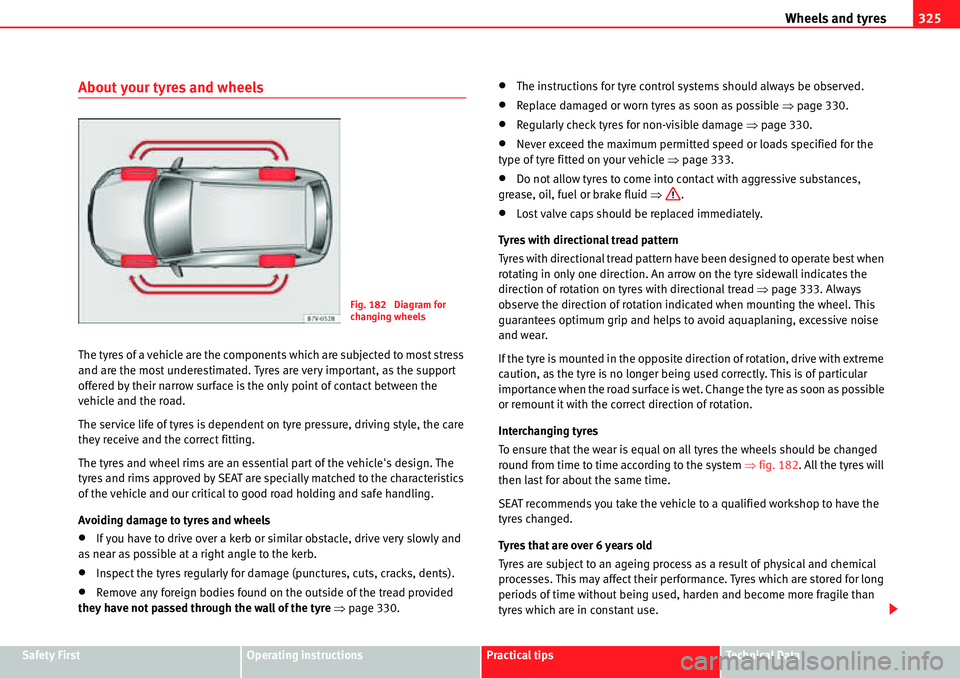
Wheels and tyres325
Safety FirstOperating instructionsPractical tipsTe c h n i c a l D a t a
About your tyres and wheels
The tyres of a vehicle are the components which are subjected to most stress
and are the most underestimated. Tyres are very important, as the support
offered by their narrow surface is the only point of contact between the
vehicle and the road.
The service life of tyres is dependent on tyre pressure, driving style, the care
they receive and the correct fitting.
The tyres and wheel rims are an essential part of the vehicle's design. The
tyres and rims approved by SEAT are specially matched to the characteristics
of the vehicle and our critical to good road holding and safe handling.
Avoiding damage to tyres and wheels
�xIf you have to drive over a kerb or similar obstacle, drive very slowly and
as near as possible at a right angle to the kerb.
�xInspect the tyres regularly for damage (punctures, cuts, cracks, dents).
�xRemove any foreign bodies found on the outside of the tread provided
they have not passed through the wall of the tyre �Ÿpage 330.
�xThe instructions for tyre control systems should always be observed.
�xReplace damaged or worn tyres as soon as possible �Ÿpage 330.
�xRegularly check tyres for non-visible damage �Ÿpage 330.
�xNever exceed the maximum permitted speed or loads specified for the
type of tyre fitted on your vehicle �Ÿpage 333.
�xDo not allow tyres to come into contact with aggressive substances,
grease, oil, fuel or brake fluid �Ÿ.
�xLost valve caps should be replaced immediately.
Tyres with directional tread pattern
Tyres with directional tread pattern have been designed to operate best when
rotating in only one direction. An arrow on the tyre sidewall indicates the
direction of rotation on tyres with directional tread �Ÿpage 333. Always
observe the direction of rotation indicated when mounting the wheel. This
guarantees optimum grip and helps to avoid aquaplaning, excessive noise
and wear.
If the tyre is mounted in the opposite direction of rotation, drive with extreme
caution, as the tyre is no longer being used correctly. This is of particular
importance when the road surface is wet. Change the tyre as soon as possible
or remount it with the correct direction of rotation.
Interchanging tyres
To ensure that the wear is equal on all tyres the wheels should be changed
round from time to time according to the system �Ÿfig. 182. All the tyres will
then last for about the same time.
SEAT recommends you take the vehicle to a qualified workshop to have the
tyres changed.
Tyres that are over 6 years old
Tyres are subject to an ageing process as a result of physical and chemical
processes. This may affect their performance. Tyres which are stored for long
periods of time without being used, harden and become more fragile than
tyres which are in constant use.
Fig. 182 Diagram for
changing wheels
Page 329 of 413
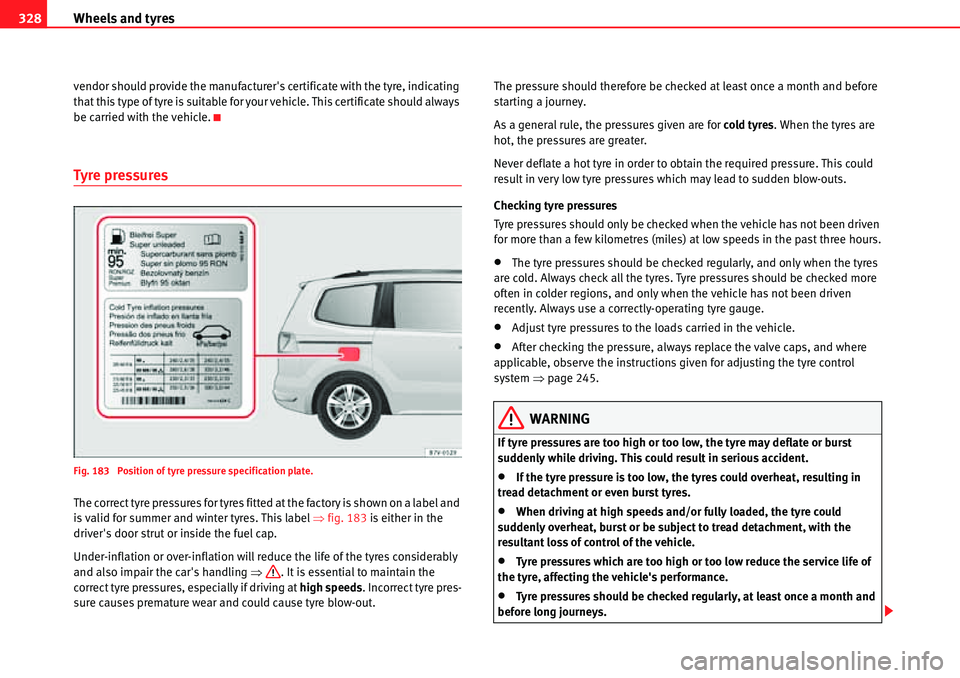
Wheels and tyres 328
vendor should provide the manufacturer's certificate with the tyre, indicating
that this type of tyre is suitable for your vehicle. This certificate should always
be carried with the vehicle.
Tyre pressures
Fig. 183 Position of tyre pressure specification plate.
The correct tyre pressures for tyres fitted at the factory is shown on a label and
is valid for summer and winter tyres. This label �Ÿfig. 183 is either in the
driver's door strut or inside the fuel cap.
Under-inflation or over-inflation will reduce the life of the tyres considerably
and also impair the car's handling �Ÿ. It is essential to maintain the
correct tyre pressures, especially if driving at high speeds. Incorrect tyre pres-
sure causes premature wear and could cause tyre blow-out.The pressure should therefore be checked at least once a month and before
starting a journey.
As a general rule, the pressures given are for cold tyres. When the tyres are
hot, the pressures are greater.
Never deflate a hot tyre in order to obtain the required pressure. This could
result in very low tyre pressures which may lead to sudden blow-outs.
Checking tyre pressures
Tyre pressures should only be checked when the vehicle has not been driven
for more than a few kilometres (miles) at low speeds in the past three hours.
�xThe tyre pressures should be checked regularly, and only when the tyres
are cold. Always check all the tyres. Tyre pressures should be checked more
often in colder regions, and only when the vehicle has not been driven
recently. Always use a correctly-operating tyre gauge.
�xAdjust tyre pressures to the loads carried in the vehicle.
�xAfter checking the pressure, always replace the valve caps, and where
applicable, observe the instructions given for adjusting the tyre control
system �Ÿpage 245.
WARNING
If tyre pressures are too high or too low, the tyre may deflate or burst
suddenly while driving. This could result in serious accident.
�xIf the tyre pressure is too low, the tyres could overheat, resulting in
tread detachment or even burst tyres.
�xWhen driving at high speeds and/or fully loaded, the tyre could
suddenly overheat, burst or be subject to tread detachment, with the
resultant loss of control of the vehicle.
�xTyre pressures which are too high or too low reduce the service life of
the tyre, affecting the vehicle's performance.
�xTyre pressures should be checked regularly, at least once a month and
before long journeys.
Page 330 of 413
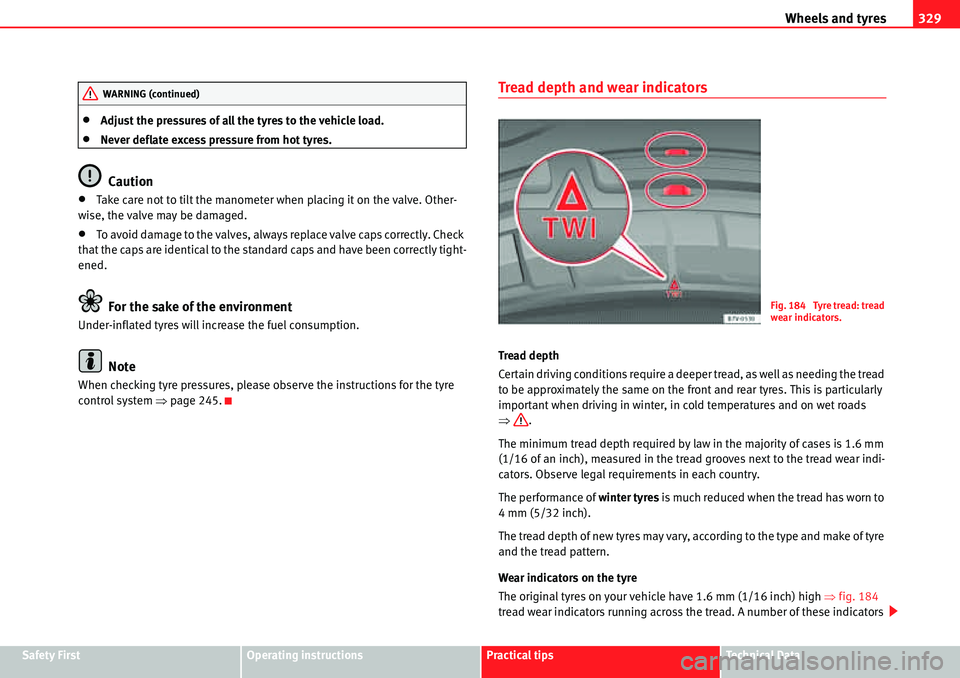
Wheels and tyres329
Safety FirstOperating instructionsPractical tipsTe c h n i c a l D a t a
�xAdjust the pressures of all the tyres to the vehicle load.
�xNever deflate excess pressure from hot tyres.
Caution
�xTake care not to tilt the manometer when placing it on the valve. Other-
wise, the valve may be damaged.
�xTo avoid damage to the valves, always replace valve caps correctly. Check
that the caps are identical to the standard caps and have been correctly tight-
ened.
For the sake of the environment
Under-inflated tyres will increase the fuel consumption.
Note
When checking tyre pressures, please observe the instructions for the tyre
control system �Ÿpage 245.
Tread depth and wear indicators
Tread depth
Certain driving conditions require a deeper tread, as well as needing the tread
to be approximately the same on the front and rear tyres. This is particularly
important when driving in winter, in cold temperatures and on wet roads
�Ÿ.
The minimum tread depth required by law in the majority of cases is 1.6 mm
(1/16 of an inch), measured in the tread grooves next to the tread wear indi-
cators. Observe legal requirements in each country.
The performance of winter tyres is much reduced when the tread has worn to
4 mm (5/32 inch).
The tread depth of new tyres may vary, according to the type and make of tyre
and the tread pattern.
Wear indicators on the tyre
The original tyres on your vehicle have 1.6 mm (1/16 inch) high �Ÿfig. 184
tread wear indicators running across the tread. A number of these indicators
WARNING (continued)
Fig. 184 Tyre tread: tread
wear indicators.
Page 374 of 413
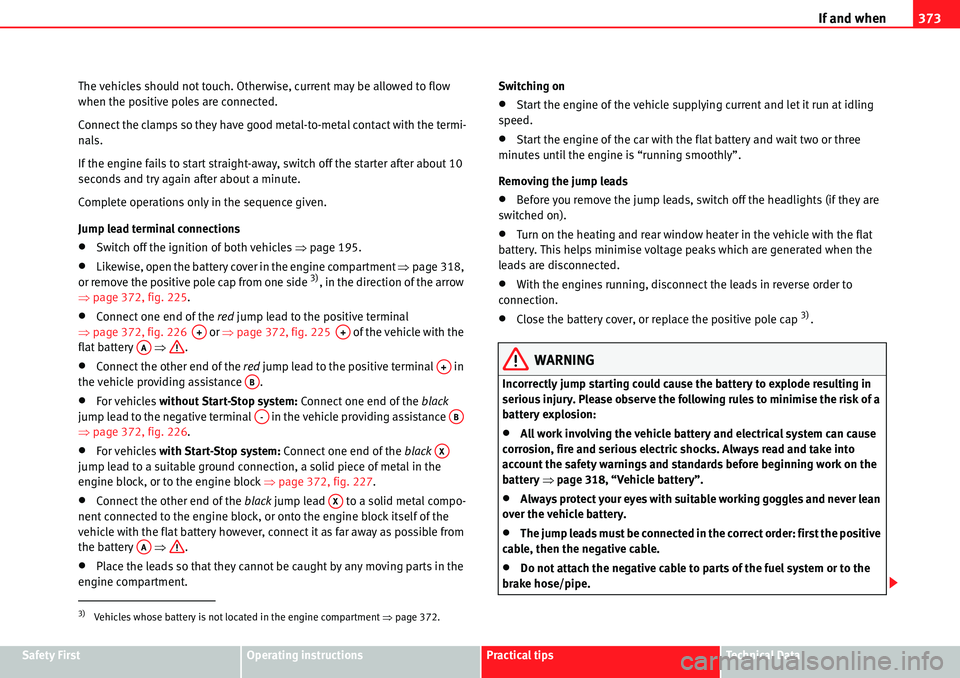
If and when373
Safety FirstOperating instructionsPractical tipsTe c h n i c a l D a t a The vehicles should not touch. Otherwise, current may be allowed to flow
when the positive poles are connected.
Connect the clamps so they have good metal-to-metal contact with the termi-
nals.
If the engine fails to start straight-away, switch off the starter after about 10
seconds and try again after about a minute.
Complete operations only in the sequence given.
Jump lead terminal connections
�xSwitch off the ignition of both vehicles �Ÿpage 195.
�xLikewise, open the battery cover in the engine compartment �Ÿpage 318,
or remove the positive pole cap from one side 3), in the direction of the arrow
�Ÿpage 372, fig. 225.
�xConnect one end of the red jump lead to the positive terminal
�Ÿpage 372, fig. 226 or �Ÿpage 372, fig. 225 of the vehicle with the
flat battery �Ÿ.
�xConnect the other end of the red jump lead to the positive terminal in
the vehicle providing assistance .
�xFor vehicles without Start-Stop system: Connect one end of the black
jump lead to the negative terminal in the vehicle providing assistance
�Ÿpage 372, fig. 226.
�xFor vehicles with Start-Stop system: Connect one end of the black
jump lead to a suitable ground connection, a solid piece of metal in the
engine block, or to the engine block �Ÿpage 372, fig. 227.
�xConnect the other end of the black jump lead to a solid metal compo-
nent connected to the engine block, or onto the engine block itself of the
vehicle with the flat battery however, connect it as far away as possible from
the battery �Ÿ.
�xPlace the leads so that they cannot be caught by any moving parts in the
engine compartment.Switching on
�xStart the engine of the vehicle supplying current and let it run at idling
speed.
�xStart the engine of the car with the flat battery and wait two or three
minutes until the engine is “running smoothly”.
Removing the jump leads
�xBefore you remove the jump leads, switch off the headlights (if they are
switched on).
�xTurn on the heating and rear window heater in the vehicle with the flat
battery. This helps minimise voltage peaks which are generated when the
leads are disconnected.
�xWith the engines running, disconnect the leads in reverse order to
connection.
�xClose the battery cover, or replace the positive pole cap 3).
WARNING
Incorrectly jump starting could cause the battery to explode resulting in
serious injury. Please observe the following rules to minimise the risk of a
battery explosion:
�xAll work involving the vehicle battery and electrical system can cause
corrosion, fire and serious electric shocks. Always read and take into
account the safety warnings and standards before beginning work on the
battery �Ÿpage 318, “Vehicle battery”.
�xAlways protect your eyes with suitable working goggles and never lean
over the vehicle battery.
�xThe jump leads must be connected in the correct order: first the positive
cable, then the negative cable.
�xDo not attach the negative cable to parts of the fuel system or to the
brake hose/pipe.
3)Vehicles whose battery is not located in the engine compartment �Ÿpage 372.
A+A+AA
A+AB
A-AB
AX
AX
AA
Page 382 of 413

General notes on the technical data381
Safety FirstOperating instructionsPractical tipsTe c h n i c a l D a t a
Data on fuel consumption
Fuel consumption
The consumption and emission details shown on the vehicle
data sticker differ from one vehicle to another.
The fuel consumption, CO2 emissions and actual kerb weight of the vehicle
are noted on the vehicle data sticker.
The fuel consumption and emissions figures given are based on the vehicle
weight category, which is determined according to the engine/gearbox
combination and the equipment fitted.
The consumption and emission figures are calculated in accordance with the
EC test requirements 1999/100/EC. These test requirements specify a real-
istic test method based on normal everyday driving.
The following test conditions are applied:
Note
�xActual consumption may vary from quoted test values, depending on
personal driving style, road and traffic conditions, the weather and the
vehicle condition.
Weights
Kerb weight refers to the basic model with a fuel tank filled to 90% capacity
and without optional extras. The figure quoted includes 75 kg to allow for the
weight of the driver.
For special versions and optional equipment fittings or for the addition of
accessories, the weight of the vehicle will increase �Ÿ.
WARNING
�xPlease note that the centre of gravity may shift when transporting
heavy objects; this may affect the vehicle's handling and lead to an acci-
dent. Always adjust your speed and driving style to suit road conditions
and requirements.
�xNever exceed the gross axle weight rating or the gross vehicle weight
rating. If the allowed axle load or the allowed total weight is exceeded, the
driving characteristics of the vehicle may change, leading to accidents,
injuries and damage to the vehicle.
Urban cycleThe urban cycle starts with an engine cold start. City driving
is then simulated.
Extra urban
cycleIn the extra urban cycle simulation the vehicle frequently
accelerates and brakes in all gears, as in normal everyday
driving. The road speed ranges from 0 to 120 km/h.
Total con-
sumptionThe average total consumption is calculated with a weighting
of around 37% for the urban cycle and 63% for the extra
urban cycle.
CO2 emis-
sionsThe exhaust gases are collected during both driving cycles to
calculate carbon dioxide emissions. The gas composition is
then analysed to evaluate the CO
2 content and other emis-
sions.
Page 385 of 413
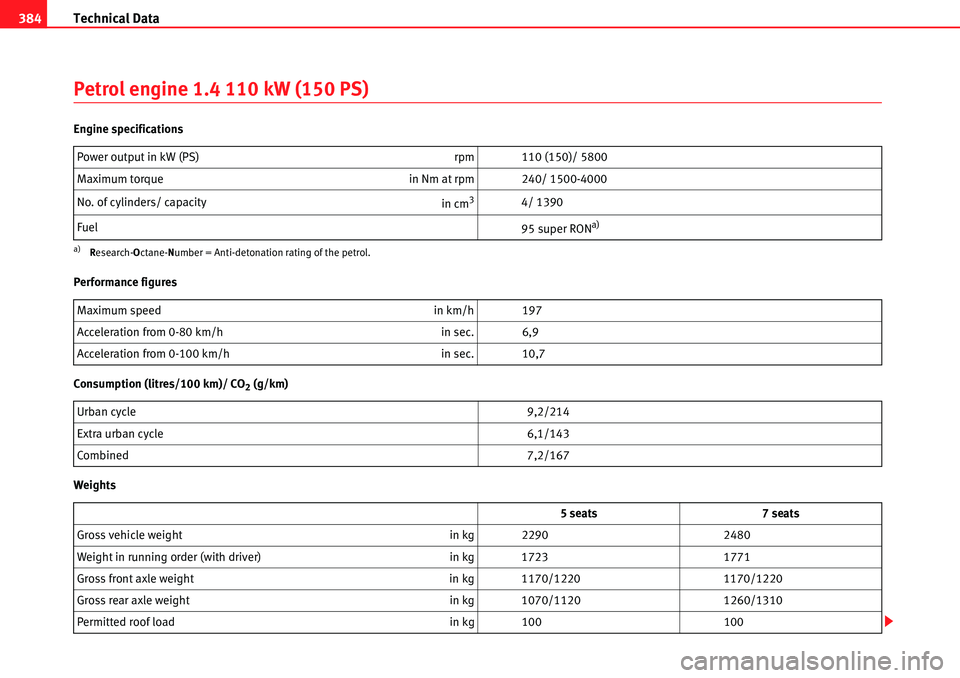
Technical Data 384
Petrol engine 1.4 110 kW (150 PS)
Engine specifications
Performance figures
Consumption (litres/100 km)/ CO
2 (g/km)
WeightsPower output in kW (PS) rpm 110 (150)/ 5800
Maximum torque in Nm at rpm 240/ 1500-4000
No. of cylinders/ capacity
in cm
34/ 1390
Fuel
95 super RON
a)
a)Research-Octane-Number = Anti-detonation rating of the petrol.
Maximum speed in km/h 197
Acceleration from 0-80 km/h in sec. 6,9
Acceleration from 0-100 km/h in sec. 10,7
Urban cycle9,2/214
Extra urban cycle 6,1/143
Combined7,2/167
5 seats 7 seats
Gross vehicle weight in kg 2290 2480
Weight in running order (with driver) in kg 1723 1771
Gross front axle weight in kg 1170/1220 1170/1220
Gross rear axle weight in kg 1070/1120 1260/1310
Permitted roof load in kg 100 100
Page 386 of 413
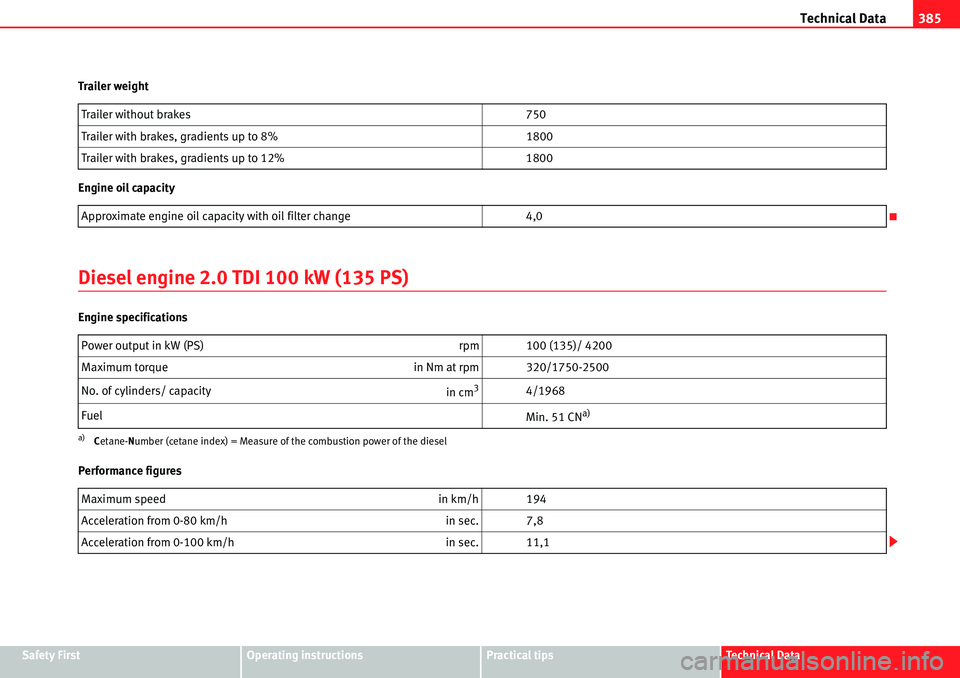
Technical Data385
Safety FirstOperating instructionsPractical tipsTe c h n i c a l D a t a Trailer weight
Engine oil capacity
Diesel engine 2.0 TDI 100 kW (135 PS)
Engine specifications
Performance figuresTrailer without brakes 750
Trailer with brakes, gradients up to 8% 1800
Trailer with brakes, gradients up to 12% 1800
Approximate engine oil capacity with oil filter change 4,0
Power output in kW (PS) rpm 100 (135)/ 4200
Maximum torque in Nm at rpm 320/1750-2500
No. of cylinders/ capacity
in cm
34/1968
Fuel
Min. 51 CN
a)
a)Cetane-Number (cetane index) = Measure of the combustion power of the diesel
Maximum speed in km/h 194
Acceleration from 0-80 km/h in sec. 7,8
Acceleration from 0-100 km/h in sec. 11,1
Page 388 of 413
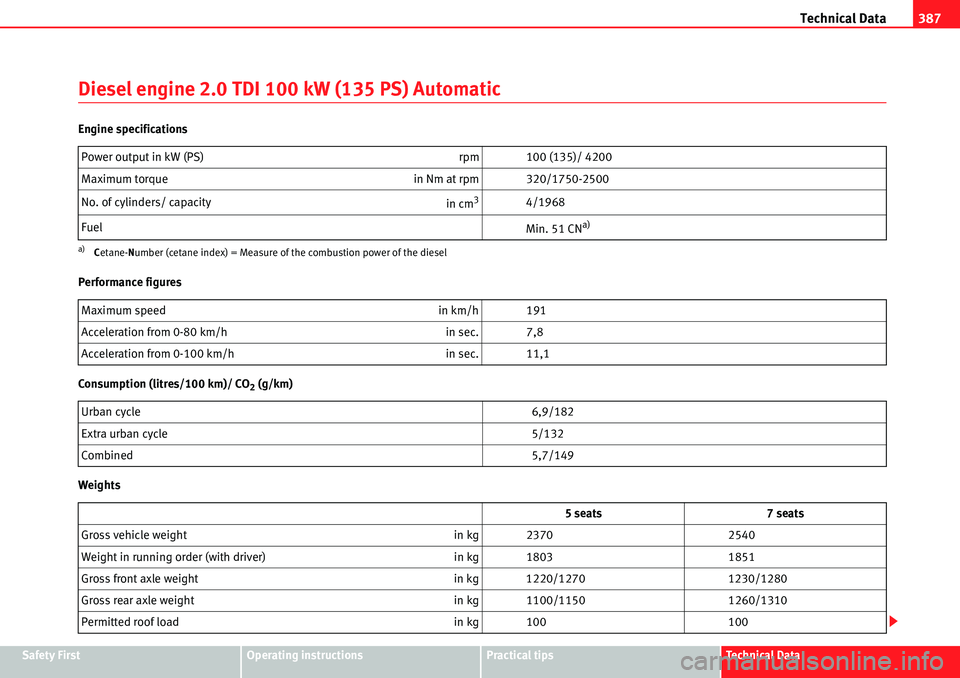
Technical Data387
Safety FirstOperating instructionsPractical tipsTe c h n i c a l D a t a
Diesel engine 2.0 TDI 100 kW (135 PS) Automatic
Engine specifications
Performance figures
Consumption (litres/100 km)/ CO
2 (g/km)
WeightsPower output in kW (PS) rpm 100 (135)/ 4200
Maximum torque in Nm at rpm 320/1750-2500
No. of cylinders/ capacity
in cm
34/1968
Fuel
Min. 51 CN
a)
a)Cetane-Number (cetane index) = Measure of the combustion power of the diesel
Maximum speed in km/h 191
Acceleration from 0-80 km/h in sec. 7,8
Acceleration from 0-100 km/h in sec. 11,1
Urban cycle6,9/182
Extra urban cycle 5/132
Combined5,7/149
5 seats 7 seats
Gross vehicle weight in kg 2370 2540
Weight in running order (with driver) in kg 1803 1851
Gross front axle weight in kg 1220/1270 1230/1280
Gross rear axle weight in kg 1100/1150 1260/1310
Permitted roof load in kg 100 100
Page 389 of 413
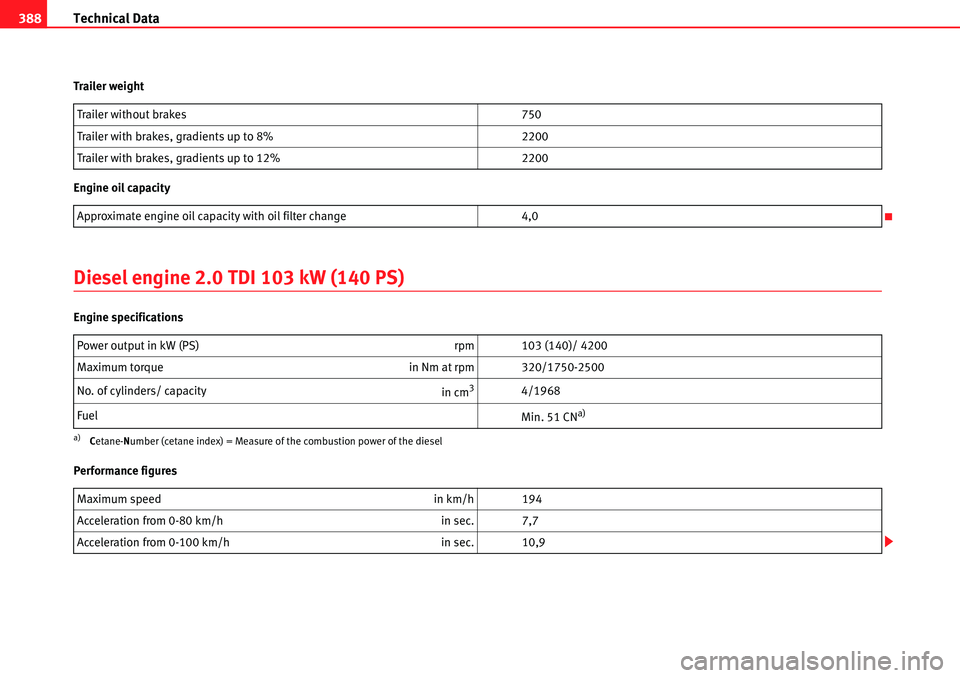
Technical Data 388
Trailer weight
Engine oil capacity
Diesel engine 2.0 TDI 103 kW (140 PS)
Engine specifications
Performance figuresTrailer without brakes 750
Trailer with brakes, gradients up to 8% 2200
Trailer with brakes, gradients up to 12% 2200
Approximate engine oil capacity with oil filter change 4,0
Power output in kW (PS) rpm 103 (140)/ 4200
Maximum torque in Nm at rpm 320/1750-2500
No. of cylinders/ capacity
in cm
34/1968
Fuel
Min. 51 CN
a)
a)Cetane-Number (cetane index) = Measure of the combustion power of the diesel
Maximum speed in km/h 194
Acceleration from 0-80 km/h in sec. 7,7
Acceleration from 0-100 km/h in sec. 10,9
Page 391 of 413
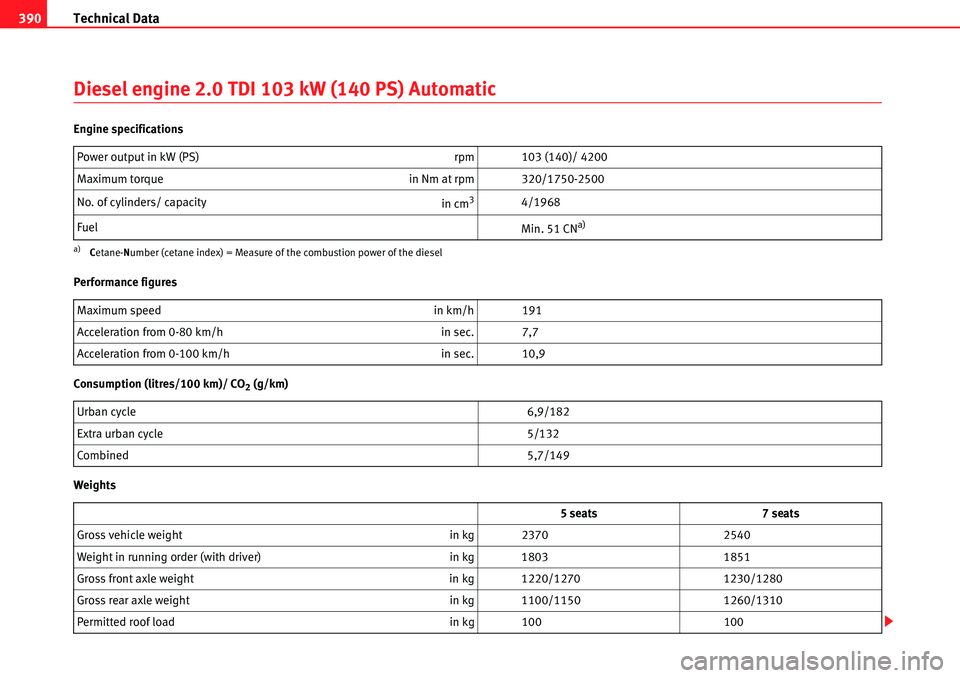
Technical Data 390
Diesel engine 2.0 TDI 103 kW (140 PS) Automatic
Engine specifications
Performance figures
Consumption (litres/100 km)/ CO
2 (g/km)
WeightsPower output in kW (PS) rpm 103 (140)/ 4200
Maximum torque in Nm at rpm 320/1750-2500
No. of cylinders/ capacity
in cm
34/1968
Fuel
Min. 51 CN
a)
a)Cetane-Number (cetane index) = Measure of the combustion power of the diesel
Maximum speed in km/h 191
Acceleration from 0-80 km/h in sec. 7,7
Acceleration from 0-100 km/h in sec. 10,9
Urban cycle6,9/182
Extra urban cycle 5/132
Combined5,7/149
5 seats 7 seats
Gross vehicle weight in kg 2370 2540
Weight in running order (with driver) in kg 1803 1851
Gross front axle weight in kg 1220/1270 1230/1280
Gross rear axle weight in kg 1100/1150 1260/1310
Permitted roof load in kg 100 100